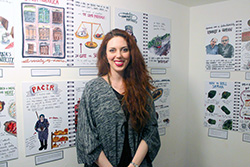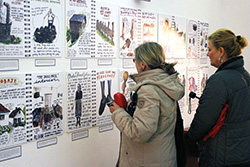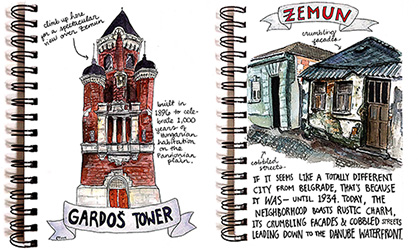Traces
SERBIA IN THE EYES AND SKETCHES OF EMMA FICK, AN AMERICAN
Corners and Edges of the Everyday
She travels and draws. Is there a better profession in the world? Detail by detail, this creative girl is making a portrait of Serbia. She reminds us of a beauty of little things, there, around us, and still misplaced in hustle and bustle of our lives. She provides clips from our excitingly plain lives. First she fills her album online, then moves it to a gallery. She is now preparing her illustrated guide through Serbia
Text and photographs: Dragana Barjaktarević
 We sometimes forget that our special traits. Sometimes we take them for granted. We pass by, without noticing the details. We eat on foot, quickly, and we don’t feel the taste. Sometimes we are even embarrassed. Then it is good to see ourselves in a thrilled eye of a foreigner. Or in his drawing book. ”Details, which you might not see, because you are used to them, like Serbian specialties, interesting market vendors, beautiful monasteries, cathedrals, picturesque landscapes and customs, thrill me”, says Emma Fick.
We sometimes forget that our special traits. Sometimes we take them for granted. We pass by, without noticing the details. We eat on foot, quickly, and we don’t feel the taste. Sometimes we are even embarrassed. Then it is good to see ourselves in a thrilled eye of a foreigner. Or in his drawing book. ”Details, which you might not see, because you are used to them, like Serbian specialties, interesting market vendors, beautiful monasteries, cathedrals, picturesque landscapes and customs, thrill me”, says Emma Fick.
Emma Fick is an American in Serbia. She was born in Louisiana, USA. She graduated English literature and art history. Last year, she was awarded Fulbright scholarship for teaching English in Novi Pazar. She didn’t have a clear idea as to where she was going, and what she found here has surpassed her expectations. Images so strong, sparkling and full of life that she could not resist putting them on paper. She has always liked to draw, and the coming to Serbia has restored that love.
 After expiry of the scholarship, in cooperation with the American Embassy in Belgrade, she started traveling around Serbia and illustrating what she sees, hears and feels. Emma is not an ordinary tourist. She does not draw the mandatory items from a guide book. She draws ”corners and edges of the everyday”. ”Plazma Biscuit”, fruit preserve, ajvar, ćevapi, dinner on Saint Day, green market stall, honey rakia, boza, elderberry juice, recipe for making kajmak and tufahije, instructions for stuffing sour cabbage leaves, wool socks, košava wind, Ada Ciganlija, Zemun, people of Zemun, people in the public transportation, friends, their mothers and grandmothers... because everyday life really is the most interesting. Emma uses clips from that life to fill her album Snippets of Serbia. First online, and then she moved them to ”Impact hub” Gallery. We met her there, on the last day of her exhibition, and we talked to her.
After expiry of the scholarship, in cooperation with the American Embassy in Belgrade, she started traveling around Serbia and illustrating what she sees, hears and feels. Emma is not an ordinary tourist. She does not draw the mandatory items from a guide book. She draws ”corners and edges of the everyday”. ”Plazma Biscuit”, fruit preserve, ajvar, ćevapi, dinner on Saint Day, green market stall, honey rakia, boza, elderberry juice, recipe for making kajmak and tufahije, instructions for stuffing sour cabbage leaves, wool socks, košava wind, Ada Ciganlija, Zemun, people of Zemun, people in the public transportation, friends, their mothers and grandmothers... because everyday life really is the most interesting. Emma uses clips from that life to fill her album Snippets of Serbia. First online, and then she moved them to ”Impact hub” Gallery. We met her there, on the last day of her exhibition, and we talked to her.
 What was your first impression about Serbia? And what is it now?
What was your first impression about Serbia? And what is it now?
When I arrived in Serbia, I was completely disoriented. It was rainy, cold and grey for the entire first week. I stayed with an older cousin. I had no internet, map or any contact in Belgrade. That first week I didn’t go out at all. I only went shopping or walking my cousin’s dog. It is funny when I compare that feeling of disorientation and isolation with what I feel now – warmth, understanding and comfort.
You studied English literature and art history. You came here to teach English. How did you start making sketches of Serbia?
It happened naturally. I had more free time and abundance of inspiration. I bought a drawing book and watercolors and started painting. And I couldn’t stop. And the more I painted Serbia, the more I was falling in love with it.
Is this the first time for you to draw a country?
Yes. Serbia is, I hope, only the first one in a row, because I like the idea of building a career of a cultural illustrator.
LITTLE, BIG, AND EVERYTHING IN BETWEEN
 What are the scenes that inspire you to take out paper and pencil and draw them?
What are the scenes that inspire you to take out paper and pencil and draw them?
I have always noticed details. Formerly, I would point them out: ”Hey, look at this!” And today I take paper and pencil and I draw them. Sometimes I am inspired by al little fruit, sometimes by a huge palace. There are no rules. Little, big, what fits in between – if they draw attention, everything is equally important.
Do you have your favorite ”snippet”?
No. The project makes sense when it is observed as a whole. Separating one snippet would mean pulling it out of context. Altogether they comprise the complete image of my vision of life in Serbia.
 And what is the first image that you see when you think of Serbia? What is it that makes us unique in your eyes?
And what is the first image that you see when you think of Serbia? What is it that makes us unique in your eyes?
Cheerful spirit. Serbia has a complex history that has left its trace in everything – from architecture to mentality. For a people that suffered so much, Serbs have unbelievably positive view of life. They know how to enjoy and share joy with others.
You often draw scenes from green market, method of preparing food, traditional dishes and drinks, tables covered with delicacies... Do you have a favorite Serbian dish? And have you learned to cook one yourself?
It is impossible to answer that question! If I should have a quick breakfast or lunch, I go to a bakery shop for a pie and yoghurt. I like fish stew, Šopska and Moravska salads, and ajvar, of course – with anything. I have watched people preparing food. It seems that Serbs make even the most difficult dishes with ease. I have learned to make a pie, and I hope that sarma will be the next.
SERBIA FOR THE BEGINNERS
You also draw various corners of Belgrade. Do you have a favorite part of the city?
I love Dorćol, Savamala, Zemun and all places where there is green market.
Before Belgrade, you lived in Novi Pazar.
These are two separate worlds. On the other hand, entire Serbia is like this – small, but very diverse! Influences of various cultures are visible already at first sight.
 Traveling around Serbia, you must have experienced anecdotes worth telling. Can you single one out?
Traveling around Serbia, you must have experienced anecdotes worth telling. Can you single one out?
In front of a little church in the hills of Southwest Serbia, an old man offered me a bottle of transparent liquid, showing me to take a sip. I didn’t want to be rude, so I took a big sip, expecting it to be water. It turned out to be rakia. I didn’t feel well, and the old man laughed his heart out.
How do you overcome the language barrier?
Most people, especially young ones, are fluent in English. besides that, non-verbal communication is more efficient than it seems. I had a great time with people with whom I was not able to communicate at all. It turned out that my poor knowledge of Serbian and some knowledge of English of the people I was talking to could be enough. Anyway, I am here to communicate through illustrations.
You have experienced different areas of or country well enough to be able to give advice to a traveller who comes here: what i it that people must not miss in Serbia?
I cannot even mention everything. But here are a few examples: Serbian cuisine, going to a tavern, wandering through the streets of Belgrade and enjoying the variety of architecture. Also, a short trip to another town in order to feel the diversity of Serbian culture. And to visit at least one village: Or two.
***
Not by Accident
During World War II, a Serb to whom her grandmother’s aunt was married helped her family of Jewish origin to flee from Vienna first to Belgrade, and then he paid for their entire trip to America. That is why she has chosen to come to Serbia as a Fulbright fellow. In addition to the family story, she didn’t know anything about Serbia.
***
Instructions for Use
On every Emma’s drawing, there is also a short description of what she has drawn. Sometimes it is just a subjective view. Sometimes a definition of untranslatable local term, or instructions on how to adopt the tradition and understand Serbian mentality. Why something is beautiful, important, jinxed, inacceptable, impressive. Instructions for foreigners, reminder for us.
***
Cultural Dialogue
During this project, Emma led art workshops for elementary and high school students in several cities in Serbia. They had a task to, taking her illustrations as an example, draw and explain what, in their opinion, is specific for Serbian or American culture. The goal of the workshop was to establish a cultural dialogue and answer the question of what it is that makes a culture recognizable.
